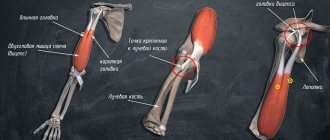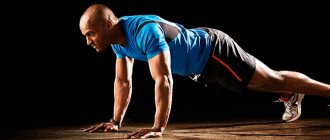Crossover curls can be performed in different ways, but they will always be isolating in nature, so this should be taken into account when you include these exercises in your training program. Firstly, biceps exercises should be performed 3-4 months after starting training in the gym, and secondly, isolating biceps exercises, in general, should be done only after the athlete has already been able to build up the muscle mass of the biceps muscle, that is, when the biceps are already at least 40 centimeters. Otherwise, to build biceps , perform heavier compound exercises that promote hypertrophy of muscle fibers rather than improving muscle quality.
Crossover curls can be performed in two ways: when the athlete pulls the handles of the machine from below to work the outer head of the biceps, and when the athlete pulls the handles of the machine from above to raise the peak and work the inner head. There are also options when arm curls in the simulator are performed for an unclear purpose, for example, loading both heads of the biceps when bending from below, repeating arm curls with a barbell, which is pointless, since in this case it is better to perform the basic exercise. But, if you need to specifically load one head of the biceps, isolating it from all other muscles after you have already loaded the biceps with other exercises, then this exercise is perfect as a “finisher”.
Benefits and disadvantages of exercise
The crossover biceps curl is a movement that has many different variations. It has a number of advantages and disadvantages compared to the classic barbell lift. Therefore, it is worth considering these exercises as complementary and not replacing each other.
The main advantages of curling your arms on a block:
- The ability to change the degree and focus of the load using different grips, handles, and performing with one or two hands.
- Helps to master the correct technique and ideal execution of the motor pattern.
- It creates tension even at the starting point due to the tension of the cable, because of this, the working muscles are constantly under load.
- Ideal for safe pumping, multi-repetition techniques, static dynamics and other techniques.
- Consistently increases the volume and strength of the biceps.
Disadvantages when working with the lower block:
- Poorly suited as a main “mass-building” exercise, inferior to working with free weights (dumbbells and barbells).
- The gym may not have a crossover (or the right handles).
Pros and cons of information
The advantages of this exercise include some of the points. Such as:
- Since the exercise is isolated, it completely excludes the triceps from the work, which takes up part of the load in almost all chest exercises. Therefore, we can only work on the target group and focus only on it.
- Unlike the same fly with dumbbells lying down, the reduction performs the main function of the pectoral muscles. That is, bringing the hands towards each other.
- A very large range of motion, which allows you to maximally stretch the pectoral muscles.
- The ability to adjust the height of the blocks, which will allow you to work your chest at various angles.
- And of course, due to the numerous variations, the exercise can load all parts of the pectoral muscle.
For me, the benefits are enough to include this exercise in your chest workout. Even despite the disadvantages. Of course, there are not so many of them to pay attention to them, but they are there. These include:
- Availability of the simulator itself. The crossover is a very popular piece of equipment in the gym and is always busy. In principle, the problem is solvable; you can always agree to do it one at a time, of course, if the right people are involved.
- And of course, don’t forget, bringing your arms together in a crossover does not build muscle mass. Therefore, if you do not have a prepared muscle mass or you just came to the gym. Then this exercise will be a waste of time for you. It’s better to start with the “Barbell Press” or “Dumbbells”.
I think if you have been going to the gym for a long time and know how to deal with queues at one or another exercise machine. And your muscle mass is admired by everyone around you. Then these disadvantages won’t even affect you.
What muscles work
When performed correctly, biceps curls are classified as isolating exercises, since only one pair of joints (the elbows) is involved in the work. The main burden falls on:
- Biceps (mostly short head).
- Brachial muscle.
- Brachioradialis muscle.
If an athlete feels tension in other muscles (for example, triceps or trapezius) when performing a cable curl while standing, this indicates incorrect technique or a lack of neuromuscular control in the target area.
Bend the arms on the lower block
The crossover version from the lower block is a classic version of the exercise. However, there are three popular variations that use different handles. Each of them has its own characteristics.
Classic technique with straight handle
- Approach the machine half a step. Take the handle in your hands and stand straight, feet shoulder-width apart.
- Bend your arms until your fist is level with your front deltoid.
- Stay in this position for 0.5 seconds, then at a slower pace, straighten your arms until your elbows are completely straight.
To more effectively perform the movement on the lower block, it is recommended to do a long delay of 1 second. Exhale while bending your arms, inhale while extending your arms.
The straight handle version is the most common. Main advantages:
- Load on the short head of the biceps.
- The option is as convenient as possible even for beginners and does not require much preparation.
- Allows you to set the highest weights in the simulator, which makes it one of the most promising for increasing strength indicators.
Bending in a block with a rope
Main features and differences when working with a rope handle in a crossover:
- Having your hands in a neutral grip (palms facing each other) puts more stress on your forearms. This is especially true for those who are lagging in this muscle group.
- To place even more stress on the forearms when performing bending, the athlete can turn the hand to the sides (so that the palms are facing upward at the top point). This helps not only strengthen the tendons, but also thicken the muscles in the forearm area.
- This technique is considered an analogue of hammer bends and switches the focus of the load from the short to the long head.
- Due to its flexibility, the rope creates less stability, forcing more stabilizer muscles to come into play.
Curls with EZ-handle
Cable curls with an EZ handle are very similar to the Scott Bench movement. Main differences:
- The load falls more on the lower part of the biceps.
- Due to the lack of triceps fixation and barbell position, more muscle fibers are involved in the work.
- You can perform the movement with a wide grip, which will partially shift the load onto the long beam.
Bending from the lower block with each hand separately
Performing the movement with one hand allows you to more specifically load the biceps and eliminate other muscles from working. However, for the exercise to be effective, it is important to follow the basic rules:
- Always do the same number of reps on each D-handle arm.
- Securely fix the body (hold the frame with your free hand) to eliminate inertia and swaying.
- Perform the movement at a slow pace (raising your arm slightly faster than lowering it).
Correct technique
- To perform the exercise correctly, you need to grab the handles of the machine from below. In this case, the elbow joints are firmly fixed in the area of the latissimus dorsi muscle and are slightly retracted back.
- The back bends, the shoulder blades move together, and the head rises up. It is important to keep your knees slightly bent so that they do not suffer from heavy load.
- If the handles allow this movement, then they can be pulled up, turning the hands so that the palms face outward.
- When the biceps contract as much as possible, the hands are moved to the side so that the athlete can perform supination.
- After pausing for a couple of seconds in the place where the peak contraction of the muscle is felt, the athlete can lower his arms to the starting position.
- The required number of repetitions is performed. For male and female beginners, it is recommended to perform 15 repetitions in 3 sets. Working weight for women should not exceed 15 kg, and for men - 25 kg.
Bending arms in a crossover from the upper block
The biceps curl on the upper block is a complex technique, so when working in this style it is recommended to use a light weight.
Technique:
- Place the D-handles into the upper blocks of the machine. Stand in the middle and grab them with your hands. Feet shoulder-width apart, back straight.
- Begin to bend your elbows, trying to bring your hands as close to your shoulders as possible.
- Pause briefly at the peak point and extend your arms until your elbows are straight.
- The biceps is always parallel to the floor.
- Also, when performing it, it is important to ensure that the elbows are directed to the sides (bringing the elbows together is a technical error).
Dumbbell raises with supination
In this exercise, you combine elbow flexion and forearm external rotation to maximally target the biceps.
Take the dumbbells with an overhand grip, bend your arms and lift your forearms while turning them outward. At the top point, the position of the hands should be the same as at the bottom: with the palms facing you. Lower your arms and perform the movement again.
Do 3-5 sets of 8-12 reps.
Recommendations
- Technique and smooth execution without jerking in this movement are more priority than the weight of the projectile.
- Try to place the movement at the end of your workout, after heavy exercises like barbell curls.
- It is optimal to perform 10-12 repetitions per set (12 for each hand when performed alternately). Also, the exercise “responds” well to a multi-repetition training regimen, 12-20 repetitions.
- Try to do no more than 3-4 working sets of curls per week.
Advantages
Since performing the crossover exercise is an isolating exercise, the athlete improves brain control over the chest area. This means that regular execution will allow you to better strain the trained area in other exercises.
In addition, light weights allow you to do a large number of repetitions. This, in turn, allows you to work out bundles that are less loaded in other trips.
By performing the exercise, bodybuilders work out the central area of the chest, and give the muscles the correct shape and relief.











